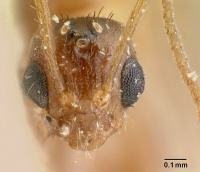Nylanderia waelbroecki
| Nylanderia waelbroecki | |
|---|---|

| |
| Scientific classification | |
| Kingdom: | Animalia |
| Phylum: | Arthropoda |
| Class: | Insecta |
| Order: | Hymenoptera |
| Family: | Formicidae |
| Subfamily: | Formicinae |
| Tribe: | Lasiini |
| Genus: | Nylanderia |
| Species: | N. waelbroecki |
| Binomial name | |
| Nylanderia waelbroecki (Emery, 1899) | |
Identification
Distribution
Distribution based on Regional Taxon Lists
Afrotropical Region: Democratic Republic of Congo (type locality).
Distribution based on AntMaps
Distribution based on AntWeb specimens
Check data from AntWeb
Countries Occupied
| Number of countries occupied by this species based on AntWiki Regional Taxon Lists. In general, fewer countries occupied indicates a narrower range, while more countries indicates a more widespread species. |

|
Estimated Abundance
| Relative abundance based on number of AntMaps records per species (this species within the purple bar). Fewer records (to the left) indicates a less abundant/encountered species while more records (to the right) indicates more abundant/encountered species. |

|
Biology
Castes
Images from AntWeb
 
| |
| Male (alate). Specimen code usnment00693679. Photographer Erin Prado, uploaded by California Academy of Sciences. | Owned by MCSN, Genoa, Italy. |
Queens are not known for this species.
Nomenclature
The following information is derived from Barry Bolton's Online Catalogue of the Ants of the World.
- waelbroecki. Prenolepis waelbroecki Emery, 1899e: 496, fig. (q.m.) DEMOCRATIC REPUBLIC OF CONGO. Forel, 1911f: 280 (w.). Combination in Pr. (Nylanderia): Wheeler, W.M. 1922a: 943; in Paratrechina (Nylanderia): Emery, 1925b: 218; in Nylanderia: LaPolla, Brady & Shattuck, 2010a: 127. See also: LaPolla, Hawkes & Fisher, 2011: 25.
Unless otherwise noted the text for the remainder of this section is reported from the publication that includes the original description.
LaPolla et al. (2011) - Despite the fact that the worker caste of this species was described by Forel (1911), we have been unable to locate worker specimens to describe here. The male of this species has very unusually shaped digiti and cuspi (see introduction). The horn-like cuspi are particularly noteworthy and unusual for the genus. Based on the overall shape of the cuspi and digiti Nylanderia jaegerskioeldi and N. waelbroecki appear to be closely related. It is possible that workers presently treated as N. jaegerskioeldi in West Africa are in fact N. waelbroecki.
Description
LaPolla et al. (2011) - The worker of this species was described by Forel (1911), but no specimens could be located for examination during this study.
Male
LaPolla et al. (2011) - Measurements (n = 3): TL: 2.2–2.4; HW: 0.52–0.58; HL: 0.57–0.61; EL: 0.24–0.27; SL: 0.64–0.75; PW: n/a; WL: 0.82–0.94; GL: 0.74–.96
Indices: CI: 90–98; REL: 43–46; SI: 122–130
Overall light brown, with darker brown abdomen; tarsi white to very light yellow, with yellow protrochanter and joints of legs; cuticle smooth and shining, covered with a dense pubescence except along mesopleuron and propodeum. Head with largely suberect macrosetae and a dense layer of pubescence. Scapes surpass posterior margin by about length of first 3–4 funicular segments; scapes with scatted erect macrosetae (SMC = 12–13) and dense layer of pubescence. Compound eyes large (taking up most of lateral margin); ocelli large and raised. Mandibular masticatory margin with prominent apical tooth; basal margin rounded, but distinct. Mesosoma with dense pubescence and scattered erect setae (PMC = 0–1; MMC = 15–19) dorsally; declivity below level of mesonotum, smooth and shining; gaster with dense pubescence and scattered erect macrosetae of varying heights. Genitalia: parameres rectangular in lateral view; apical margin medially emarginate; cuspi elongated and horn-like; apices of cuspi with finger-like projections directed posteriorly; cuspi peg-like teeth extend from region meeting with digiti to the tips of finger-like projections; digiti distinctly smaller than cuspi, blade-like; digiti with peg-like teeth on thin margin that meets cuspi.
Type Material
6 syntype males, Kinshasa, D.R. CONGO (Museo Civico di Storia Naturale, Genoa) [examined].
References
- Emery, C. 1899d. Fourmis d'Afrique. Ann. Soc. Entomol. Belg. 43: 459-504 (page 496, fig.queen, male described)
- Emery, C. 1925d. Hymenoptera. Fam. Formicidae. Subfam. Formicinae. Genera Insectorum 183: 1-302 (page 218, Combination in Paratrechina (Nylanderia))
- Forel, A. 1911g. Die Ameisen des K. Zoologischen Museums in München. Sitzungsber. Math.-Phys. Kl. K. Bayer. Akad. Wiss. Münch. 11: 249-303 (page 280, worker described)
- LaPolla, J.S., Hawkes, P.G. & Fisher, B.L. (2011) Monograph of Nylanderia (Hymenoptera: Formicidae) of the World, Part I: Nylanderia in the Afrotropics. Zootaxa 3110: 10–36.
- Wheeler, W. M. 1922j. Ants of the American Museum Congo expedition. A contribution to the myrmecology of Africa. VIII. A synonymic list of the ants of the Ethiopian region. Bull. Am. Mus. Nat. Hist. 45: 711-1004 (page 943, Combination in Pr. (Nylanderia))
References based on Global Ant Biodiversity Informatics
- Forel A. 1909. Fourmis du Musée de Bruxelles. Fourmis de Benguela récoltées par M. Creighton Wellman, et fourmis du Congo récoltées par MM. Luja, Kohl et Laurent. Annales de la Société Entomologique de Belgique 53: 51-73.
- Wheeler W. M. 1922. Ants of the American Museum Congo expedition. A contribution to the myrmecology of Africa. VIII. A synonymic list of the ants of the Ethiopian region. Bulletin of the American Museum of Natural History 45: 711-1004

